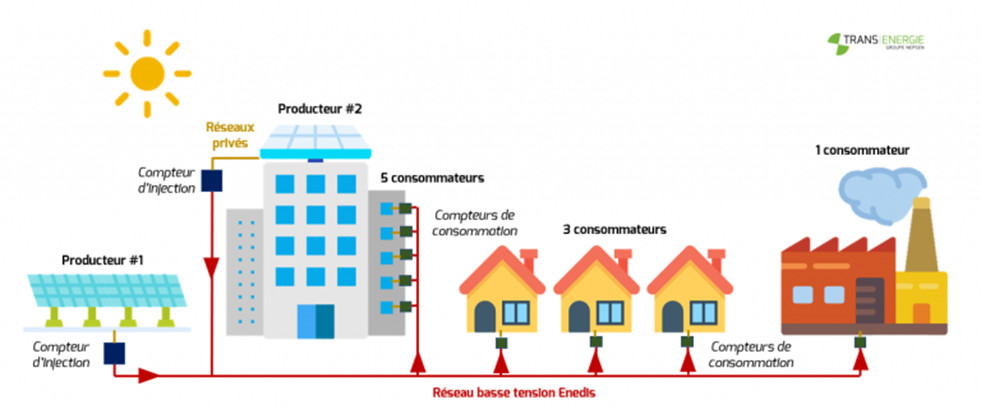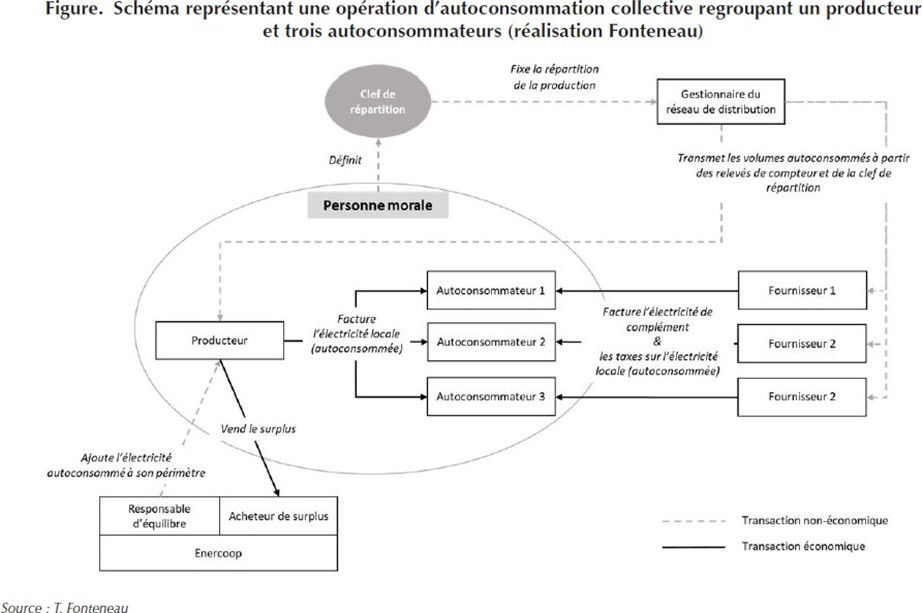On August 9, 2021, the sixth report of the Intergovernmental Panel on Climate Change (IPCC) stated that ” climate change is accelerating and intensifying “ [1]. In line with this urgency, the International Energy Agency (IEA) had called three months earlier for ” massive deployment of all available clean energy technologies, such as renewable energy ” [2]. Unlike fossil or nuclear energy sources, renewable energy sources (RE) are inherently local. They are connected to the geographical location where they are installed and they can be installed close to the places of consumption. Thus, their development leads to a revival of energy self-consumption, i.e. the direct consumption of locally produced energy. The European and French legislations support this development of individual and, more recently, collective self-consumption, in order to accelerate the diffusion of these RE. However, the implementation of this self-consumption, especially when it is collective, forces us to rethink our relationship to the public grid and to energy. In order to better understand the issues surrounding the development of collective self-consumption, a quick political and technical contextualization of this practice is first proposed. Then, the details of its implementation and operation in France are explained. Also, an example with a specialized company is presented. Finally, the inclusion of collective self-consumption in the broader socio-legal notion of energy communities is discussed.
1. Historical, technical and legal context of collective self-consumption
Individual and collective self-consumption is historically the origin of energy consumption where populations used the energy they were able to collect themselves. This notion reappeared when the decentralization of the networks was developed again.
1.1) History and position in the development of the French electricity network
To understand the sometimes hesitant emergence of individual and then collective self-consumption, it is necessary to reposition ourselves in a broader dynamic of development of the electrical system. As early as 2013, the French Court of Auditors noted inconsistencies in this long-term development strategy for the French electricity distribution system. Indeed, France, like other countries, is at a crossroads between two development scenarios for its energy system. [3]
The first scenario consists of perpetuating the centralization of this system and its national network, which is present in France today. This organization is particularly well established in this country, where centralization is historically present compared to other European countries, and where the omnipresence of nuclear energy leads to isolated, high-powered production sites that require national control. [4],p.35
This first scenario constructs an energy transition that would mainly involve nuclear power and technological advances such as thermal power plants coupled with carbon storage systems. In parallel, the development of renewable energy production means would be of great capacity (ground-based photovoltaic fields, large wind farms, off-shore wind farms, tidal power plants, STEP) and would then be distributed in a top-down manner to the consumer, who is considered as a passive customer.
The second scenario is to fully reconsider the local level in the light of renewable energies. Indeed, the latter can be implemented as decentralized energy sources, i.e. local energy production sources with small capacities (rooftop photovoltaic, citizen wind, small hydro rehabilitation, etc.). Thus, this second scenario defines local authorities and citizens as a relevant scale to operate the energy transition, notably because consumers are directly involved, through their assets, their financial investment but also their participation in organizational bodies accompanying these new practices. Becoming active, we speak of consumer-actor, or prosumer , to designate this new role that challenges the top-down and passive version of the first scenario.
These two scenarios are illustrated in Figure 1, on the left for the first scenario, on the right for the second.
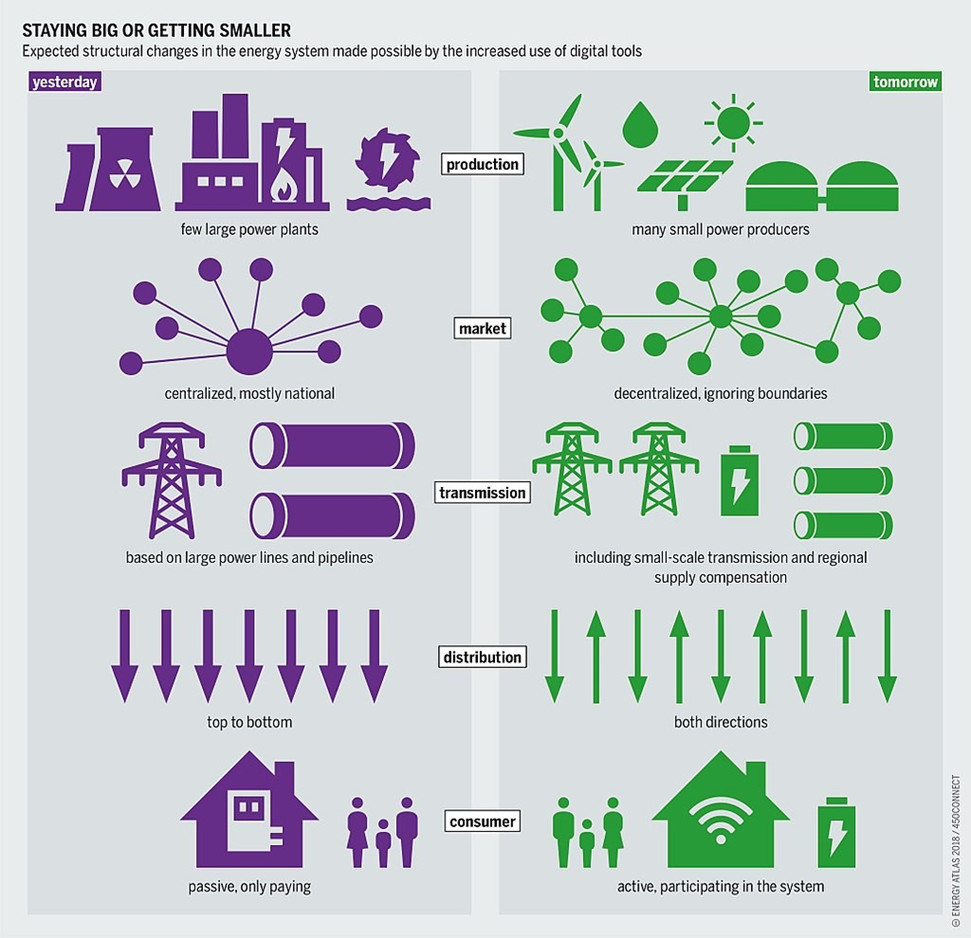
Figure 1: Illustration of the theoretical evolution of the power system towards decentralization. [Source: Energy Atlas 2018: Figures and Facts about Renewables in Europe, https://energytransition.org/2018/04/europe-must-choose-a-green-future/]
Today, there is a consensus on the need to develop renewable energies and to partially decentralize energy in France [4], p.30. (Read: Energy Decentralization in France 1980-2010: local authorities enter the scene, Energy Decentralization in France 1980-2010: energy and institutional changes and Energy Decentralization in France 2010-2020: the irruption of digital and renewable energies)
Nevertheless, it is rather around the intensity and methods of implementation of this decentralization that the various French actors diverge. The French Agency for the Environment and Energy Management (ADEME) and the ecological associations (CLER, Réseau Action Climat, AMORCE) are proactive institutions for a deep and systemic energy decentralization as proposed in the second scenario. As for the French State and the major energy players (EDF, Engie, Areva) in which the State is a shareholder, they are committed to the development of renewable energies and thus to the intrinsic decentralization that they entail. However, they influence this decentralization through a centralized conception in line with the first scenario. Indeed, “the State has appropriated wind and PV by developing its control and by associating the communities, while the large private actors have integrated them as a growth relay to develop their activity. [The State remains wary of granting too much freedom to local authorities, especially on the subject of energy, which has repercussions on sectors as diverse and sensitive for it as regional planning, social cohesion and landscape preservation. This search for coherence on a national scale has been perpetuated through successive governments and remains very present. This is particularly true of the desire to create large energy companies (GDF-Suez, Areva, EDF, Alstom, Veolia, etc.) capable of positioning themselves in European and international competition. Photovoltaics, and even more so wind power, are necessary for these large companies in the expanding international market of renewable energies. It is therefore not in the State’s interest to do without this type of company, especially since it is a shareholder in the largest of them [4],p.297
Self-consumption is essentially part of this second scenario of decentralization and active consumer because it requires the deployment of renewable energies close to the places of consumption. We can distinguish two forms of self-consumption. First, self-consumption can be individual because these prosumers produce energy for their own needs locally (in particular through rooftop photovoltaic in France). But in a second step, this self-consumption can be organized collectively in a defined area where local production and consumption are pooled for the benefit of the community: this is collective self-consumption. The interests and issues surrounding this new concept, in comparison with individual self-consumption, will be explained later.
1.2. The technical architecture necessary for collective self-consumption
Collective self-consumption is a technical challenge and its concrete realization is now possible thanks to technological advances. Indeed, the development of digital technology over the last few decades has revolutionized many sectors. It is in particular the development of communicating meters that appears as a significant technological advance. Indeed, while traditional meters record consumption for the energy distribution network manager for several months and require manual intervention to retrieve this data, communicating meters allow the digital transmission of data, almost in real time (generally with a time step of 30 minutes) (Read: Digital technology for dynamic energy management) [5].
This real-time observation and management of consumption and production of the different actors (including local renewable energy sources) thanks to communicating meters is one of the technical characteristics of a collective self-consumption operation. The latter must obviously also be composed of one or more producers, generally relying on local renewable energy sources (even if the use of generators is common abroad, especially in emerging countries); as well as consumers to use this produced energy. Also, an energy storage system can be put in place to mitigate the problem of intermittency of renewable energy sources. Thus, a collective self-consumption operation can be considered from a network point of view as shown in figure 2.
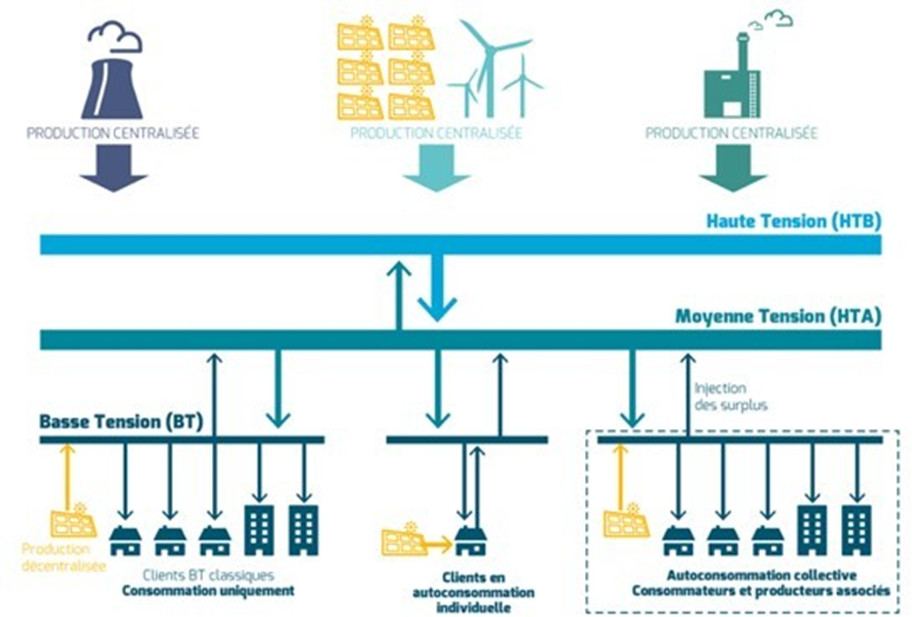
Figure 2: Schematic of collective self-consumption of electricity within the public grid. [Source: © Commission de régulation de l’énergie]
1.3 – Legal characterization
The notion of collective self-consumption appears simultaneously at the European and French levels. The term collective self-consumption was used in the Winter Package in 2016, a text that will be officially adopted in 2019 by the European Union under the name of Clean Energy Package. On the French side, collective self-consumption appears in the French law in July 2016 through Article L315-2 of the Energy Code, within the chapter dedicated more globally to self-consumption. The version in force since July 2021 states that:
” The self-consumption operation is collective when the supply of electricity is carried out between one or more producers and one or more final consumers linked together within a legal entity and whose withdrawal and injection points are located in the same building, including residential buildings. A collective self-consumption operation can be qualified as extensive when the supply of electricity is carried out between one or more producers and one or more final consumers linked together within a legal entity whose extraction and injection points are located on the low-voltage network and meet the criteria, particularly geographical proximity, set by order of the minister in charge of energy, after consultation with the Energy Regulation Commission. ”
In this legal definition, we find several perimeters for collective self-consumption. The latter is by default considered within the same building (for example, condominium). The collective self-consumption operation can also be extended if it takes place between different buildings. Until 2019, these buildings had to be located downstream of the same public transformer station from medium to low voltage. But this limitation slowed down the development of extended collective self-consumption, i.e. at the neighborhood level rather than at the building level. However, it is at the level of the district that we can exchange between actors who do not have the same consumption and production. Thus, given this mix of uses, the neighborhood level seems to offer a better potential for collective self-consumption because it allows to obtain an aggregation of electrical consumptions. We will come back later on to this notion of overflow, which is one of the main assets of collective self-consumption. Moreover, the electrical network is not necessarily representative of the geographical reality of the actors, and two neighboring buildings can be far from the public electrical network.
Thus, an order of November 2021 reindexes the perimeter of collective self-consumption according to a geographical criterion of 2 kilometers between the actors of the extended collective self-consumption operation (from the point of delivery for consumption sites and the point of injection for production sites). This decree also specifies that the cumulative power of the production facilities must be less than 3 MW and that all participants must be connected to the public low voltage (LV) or medium voltage (MV) distribution network (authorized since July 1, 2021).
Finally, it is possible to request a waiver to extend the perimeter of the operation to 20 kilometers. This derogation can be requested mainly for rural, isolated and sparsely populated areas.
1.4. Situation in France
Collective self-consumption is still a recent concept that is gradually beginning to materialize. In 2006, the introduction of very advantageous feed-in tariffs for electricity
from solar energy has allowed to launch the development of the photovoltaic sector [6][7]. It is then essentially solar installations in total sale of the produced energy which are installed in France, in order to make the most of these advantageous rates. But since then, these tariffs have been decreasing and from 2016, the installations in individual self-consumption have started to multiply. It is then in 2018 that collective self-consumption operations, a logical continuation of individual self-consumption installations, begin to appear. At the end of 2021, the number of active collective self-consumption operations in France had not yet exceeded 100, whereas individual self-consumption installations had just exceeded 100,000 connections to the French grid. The evolution of these numbers is shown in figures 3 and 4 (Read: Economic model of photovoltaic self-consumption)
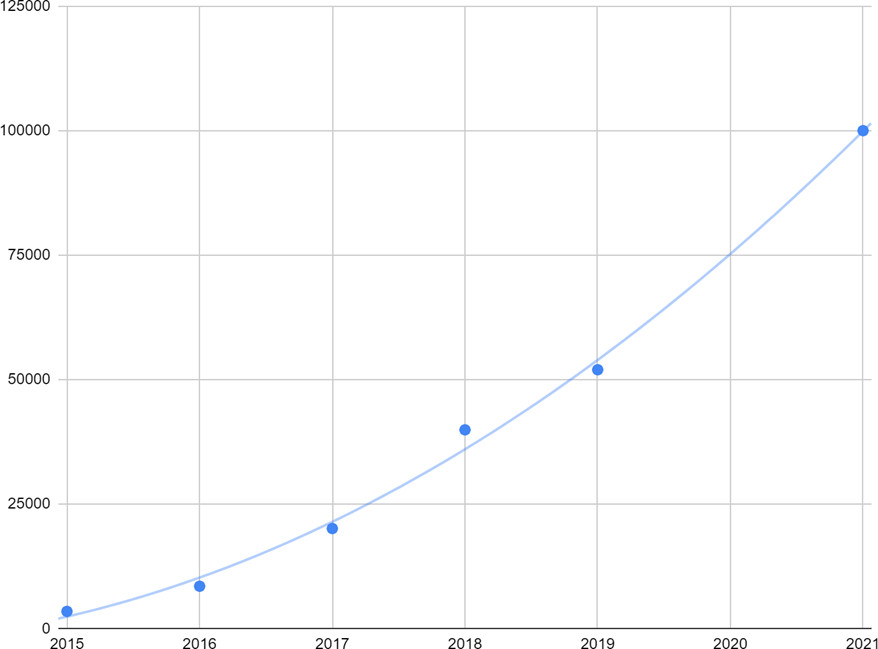
Figure 3: Individual self-consumption electricity installations connected to the grid in France. [Source: Author and data © Enedis]
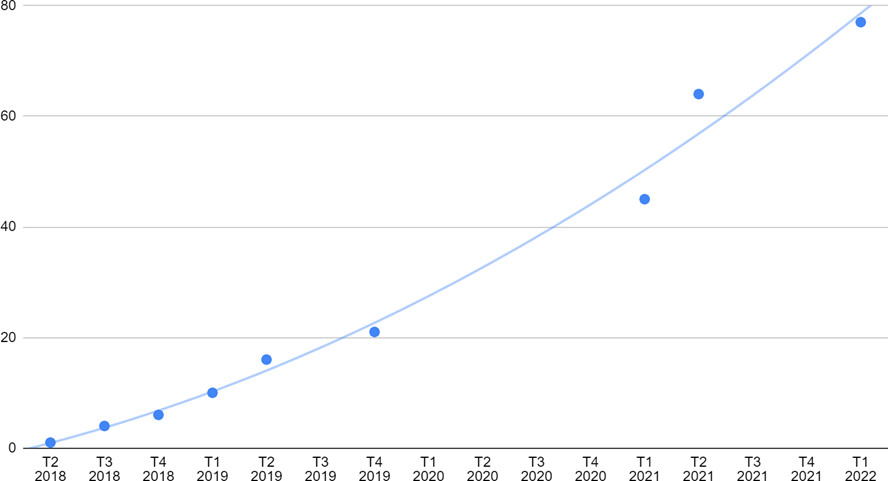
Figure 4: Number of active collective self-consumption operations in France. [Source: Author and data © Enedis]
2. How collective self-consumption works
Collective self-consumption consists in sharing the production of electricity for self-consumption between several consumers and producers linked by the same legal entity. Rules govern this operation.
2.1. Self-generation and self-consumption
Like individual self-consumption, collective self-consumption requires an understanding of two key indicators: the self-consumption rate and the self-generation rate. A visual definition is presented in Figure 5.
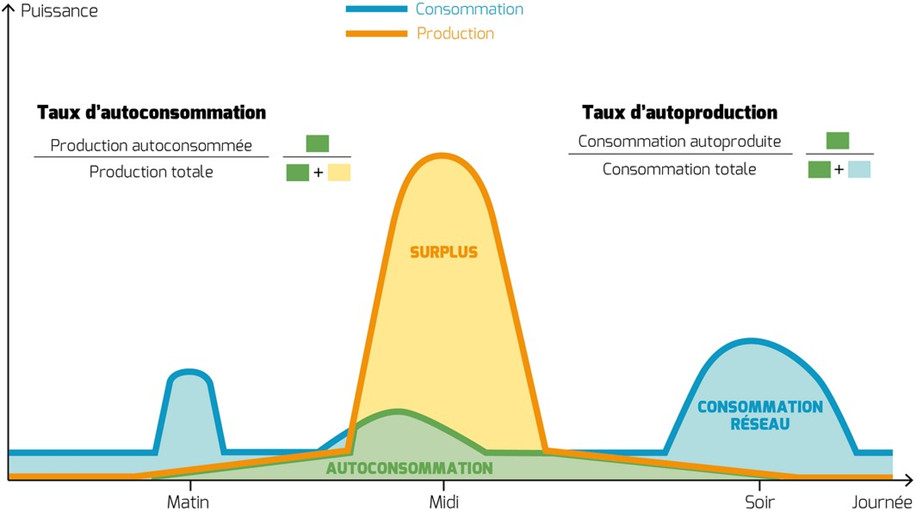
Figure 5: Explanatory diagram of self-consumption and self-generation rates. [Source: Commission de régulation de l’énergie: https://www.smartgrids-cre.fr/fileadmin/_processed_/3/f/csm_Illustration_autoconsommation_et_autoproduction_a partir_des_courbes_de_prod_et_conso_82cd873097.png]
It is not possible to size a self-consumption installation only by maximizing this indicator because it can be rather simple to have a 100% self-consumption rate. It is enough to have a small production installation compared to the consumption of the building, i.e. an undersizing of the production installations.
It is indeed necessary to combine this first rate of self-consumption with the rate of self-production. The latter is calculated by the ratio between the energy consumed by the prosumer and its total consumption over a period. It therefore defines the proportion of consumption that is covered by the production of the building. In other words, a self-production rate of 100% means that all consumption is covered by on-site production.
This rate is also called the autonomy rate because it also represents how independent the installation is from the national grid. Seeking to increase the self-generation rate can lead to unnecessary oversizing of the production facility and thus decrease the self-consumption rate. Indeed, in the case of photovoltaic in particular, one must take into account the difference in shape between the daily production curve and the daily consumption curve. For example, a photovoltaic installation will produce on average from 8am to 6pm on a sunny day following a bell-shaped curve. As long as there is consumption outside these hours, the self-production rate will be intrinsically smaller than 100%, and increasing the size of the installation will not solve this problem.
Optimizing a self-consumption installation is therefore done by optimizing these two rates simultaneously. The objective is to obtain a high self-production rate (so that the local production covers the local consumption) while keeping a high self-consumption rate (because if this rate decreases too much, it means that the installation is being oversized). However, an oversizing of the installation corresponds, on the one hand, to an economic and ecological overcost, but also, on the other hand, to an injection of more important surplus of electric production on the public network, which is today a growing problem for the latter. [10][11]
Storage elements can also be used to optimize the installation. They will significantly improve the self-generation rate because they will allow to better match the load (consumption) curve with the available energy at each time step. But it is necessary to take into account the financial and ecological cost of this solution. Moreover, the interest, in terms of CO₂ emissions, of self-consumption can vary between countries. In France, where the electricity grid is particularly decarbonized thanks to nuclear power, seeking to emancipate oneself from the public grid can quickly be more polluting than finding a compromise between self-consumption and use of this grid. [12]
These notions of self-consumption and self-production can be extended to the case of collective self-consumption. Indeed, the collective self-consumption operation, from the point of view of the network, can be considered as a single prosumer. Thus, we can define a collective self-consumption rate and a collective self-production rate. These rates are defined as before, with the difference that, for each time step, the total consumption of the collective operation is the sum of the consumptions within this operation, and the total production of the collective operation is the sum of the productions within this operation. These rates, on a collective scale, will be at least as interesting as on an individual scale because the mutualization of consumption and production can only improve the consumption – production adequacy thanks to the multiplication.
2.2. Foisonnement
One of the major interests of collective self-consumption compared to a sum of actors in individual self-consumption, lies in particular in the mix of uses that the collective self-consumption operation can represent. Indeed, the main challenge to be taken up in order to massively develop renewable energies is the correspondence between the consumption periods and the production periods of the renewable means at each moment. As we have seen previously, collective self-consumption corresponds to the connection of several producers (of renewable energy) and consumers. This organization makes it possible to consider the abundance of productions and consumptions within this entity. In other words, as the actors of the collective self-consumption operation are able to know their respective needs and to exchange on the low voltage (or medium voltage) network according to them, the simultaneity between consumption and production does not have to be done at the level of the prosumer alone, as in the case of individual self-consumption: it can be done at the level of the collective of actors. These needs can be to consume or to offload production. Thus, the aggregation of the different consumption profiles on the electrical network has a flattening effect on the general consumption curve, because not all consumption peaks are located at the same time depending on the consumers. For example, the activity in a residential building does not involve the same consumption during the day as the activity in a school or a factory. Similarly, a photovoltaic installation has a different production profile than a small hydro installation. Taking the example of an operation with several residential buildings and a business, we obtain the situation shown in Figure 6.
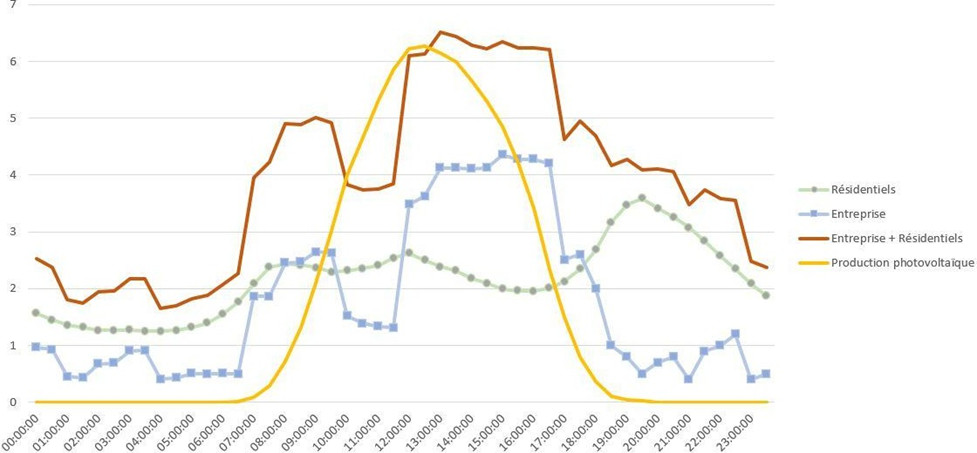
Figure 6: Illustration of the overlap between residential and business consumption profiles in relation to a photovoltaic production profile. [Source: Author and profile coefficients © Enedis]
2.3. interest of storage
Storage is also a means of matching production and consumption. Individual storage means can significantly increase individual self-consumption rates and therefore the collective self-consumption rate. It is also interesting to consider a collective storage unit, which first of all allows to reduce the financial and environmental cost compared to several individual storage units, and which would also allow to ensure a better self-production rate [13]. (Read: The breakthrough of electrical storage. What techniques? What economic functions? What future?) But the development of storage is still hesitant, especially because it lacks a legal presence. In 2019, a legal study by ADEME concluded that “this activity [storage] has no real legal recognition, which hinders the development of its use. Stationary storage facilities are assimilated to production and/or consumption activities, implying an energy tax system unfavorable to their deployment. Finally, the entire legal reasoning concerning the use of vehicles, and more broadly mobile storage, remains to be constructed.” [14]
2.4. Distribution of costs and benefits
Collective self-consumption requires management of the distribution of the costs and revenues of the operation. This management can be carried out in different ways, although it is the distribution key system that will be imposed by the Energy Code in France in 2021. These distribution keys correspond to coefficients that assign the production of the collective self-consumption operation to the consumers that make it up. These coefficients (or the method for calculating them) are provided to the distribution system operator (DSO) at each time step.
However, a clarification is needed between the physical reality and the economic accounting of flows. When we talk about “energy consumed”, “energy injected into the network” or “energy withdrawn from the network” in a collective self-consumption operation, we are talking about the contractual accounting of self-consumption rather than the physical reality. Indeed, whatever the type of production, the electrons move in the same way in the electrical network, i.e. from the place of production to the nearest place of consumption. The proof is that the choice of a distribution key is free and that different keys can change the economic values for the same physical reality. Currently in France, collective self-consumption corresponds more to a mode of economic valuation than a mode of physical distribution of electricity production.
Three types of distribution keys can be distinguished:
- Fixed allocation keys:
The distribution is made in proportion to a fixed criterion such as the surface of the dwelling of each consumer, his investment in the project or his co-ownership tantième. This organization is simple to set up but is not optimal for the operation (for example when a consumer is temporarily absent, the production that he has not consumed cannot be allocated to the other participants of the operation).
- Variable (or dynamic) allocation keys
At each 30-minute time step, the dispatch is made according to the consumption of each of the participants in the operation, recovered from the communicating meters. This is the key used by default by the network operators. It benefits all the actors but can tend to push consumption.
- Variable allocation keys according to a rule
It is possible to edit a rule specific to the collective self-consumption operation in order to optimize the distribution. For example, one can combine the two previous keys, by distributing the production according to a fixed key, which is then modulated according to the consumption at each time step. Nevertheless, this type of key requires more important calculations and data collection.
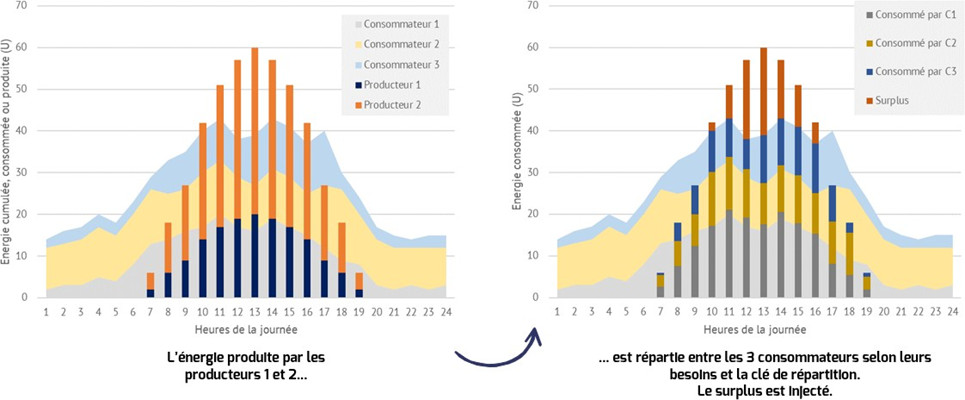
Figure 7: Example of production allocation using allocation keys. [Source: © Nepsen Transenergie, https://www.transenergie.eu/lautoconsommation-collective-cest-possible/]
2.5. Organizing Legal Person (PMO)
The Organizing Legal Entity (OLE) is the legal entity necessary for the creation of a collective self-consumption operation in France. The French law does not rule on the form it must take, this entity can therefore be a co-ownership, an association, a cooperative, etc. This structure gathers all the participants (producers and consumers) and ensures the technical and administrative link with the DSO. The latter is, by default, Enedis in France for municipalities that have not conceded this management to another entity such as the Local Distribution Company (LDC) (as is the case in Grenoble with Gaz Électricité de Grenoble (GEG)) [16].
The PMO draws up and signs a collective self-consumption agreement with the DSO. This agreement must contain the reciprocal commitments and responsibilities of the two parties, the agreement of the participants on the collection of data by the DSO and the distribution keys selected by the participants in the operation to distribute the production. The third party supplier(s) of electricity for each consumer must also be included. Indeed, in a framework of liberalization of the energy supply, they can always choose freely and independently their supplier. The agreement must also contain the network access contracts for the producer(s) [17].
Finally, we can schematize an example of collective self-consumption grouping a producer and three consumers as shown in Figure 8. Note that the diagram includes a surplus buyer. Indeed, this surplus can be economically valued or sold without remuneration to the GRD (if the installation is less than 3 kWp), which allocates it to the losses of the network. Since October 2021, this sale of the surplus can benefit from the purchase obligation mechanisms foreseen in the framework of individual self-consumption [18].
The PMO does not necessarily have all the necessary skills to coordinate all the elements required for a successful collective self-consumption operation and may need assistance.
3. Role of the Enogrid company
The management of all the elements previously presented can represent a logistical challenge in order to concretely set up a collective self-consumption operation. Out of the 77 active operations at the end of 2021 in France, about fifty of them have called upon the company Enogrid to assist them in their project and about thirty are monitored by the company. Indeed, Enogrid offers advice and support to project leaders in the study and construction phase of the operation. The company also offers software solutions for the operation and administrative management of the operation [16].
A typical dashboard of Enogrid’s software solution is presented in Figure 9. Indeed, Enogrid recorded the consumption and production data of the participants in a collective self-consumption operation during one year and calculated indicators on consumption and production over this period.
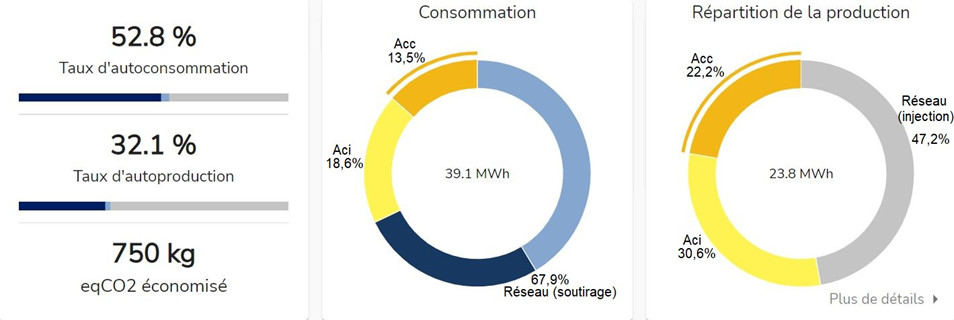
Figure 9: Data dashboard for a typical collective self-consumption operation. Aci = individual self-consumption, Acc = collective self-consumption [Source: Author © Enogrid]
4. Controversies
Various controversies are emerging about this new model for trading energy.
4.1. Profitability and TURPE
A fundamental difference between individual self-consumption and extended collective self-consumption crystallizes the tensions around this new way of exchanging energy. Indeed, extended collective self-consumption implies the transfer of energy between different actors through the low voltage (LV) or medium voltage (MV) network. Thus, unlike individual self-consumption, whose self-consumed flows remain within the private electrical structure of the prosumer, collective self-consumption uses the public distribution network to carry out its exchanges between participants.
From a fiscal point of view, the flows produced by the collective self-consumption operation are therefore subject to the different tariffs and taxes on electricity: value added tax (VAT), contribution to the public electricity service (CSPE) and tariff for the use of the public electricity network (TURPE).
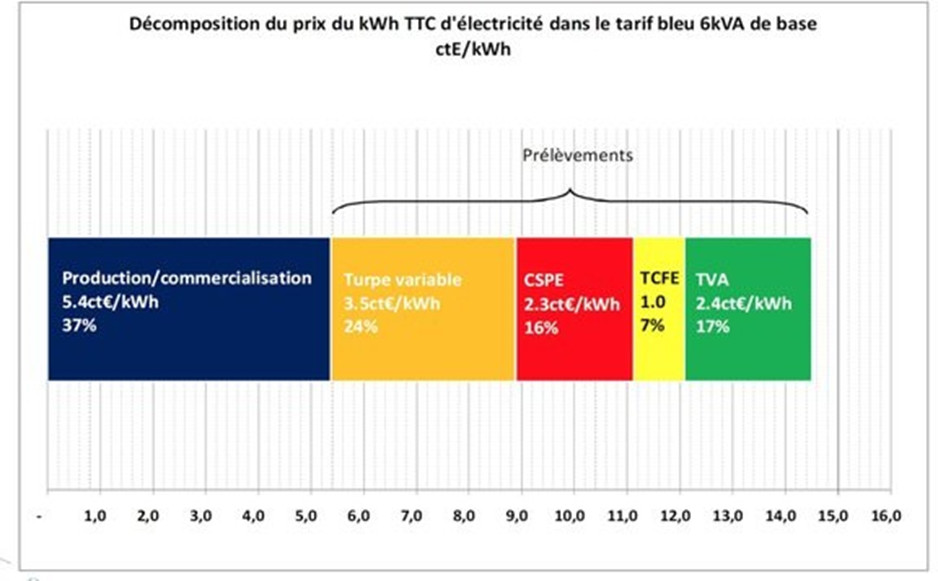
Figure 10: Breakdown of the price of electricity per kWh including tax in the basic 6kVA blue tariff ctE/kWh. [Source: Enertech, https://www.photovoltaique.info/fr/tarifs-dachat-et-autoconsommation/autoconsommation/aut oconsommation-collective/#tab-content]
“A collective self-consumer must therefore in 2017, pay these three contributions on the volume of electricity he self-consumes at the same level as for his consumption of complement (provided by his usual supplier). [Unlike the individual self-consumer, for whom the value of the electricity consumed is equivalent to the purchase price of the electricity, all taxes included, the economic value of the electricity consumed for a participant in a collective self-consumption is equivalent to the purchase price of the electricity, all taxes deducted. As taxes and levies represent about two thirds of the price of electricity, the economic model of collective self-consumption is therefore much less profitable for the self-consumers than that of individual self-consumption.” [Thibaut Fonteneau – FLUX magazine – https://www.cairn.info/revue-flux-2021-4-page-52.htm]
This description is corroborated in 2019 by a study conducted by Sia Partners’ Energy Lab in partnership with Enerplan (Syndicat de l’Énergie Solaire Renouvelable). Two use cases are simulated: a residential building of 30 dwellings and a community wishing to supply 4 public buildings in the framework of a collective self-consumption project. The payback time is 24 years in the first case and the second simulation never reaches economic balance [19].
Some actors in favor of the development of collective self-consumption are now asking for an exemption from the CSPE, but most of the discussions are oriented towards a redefinition of the TURPE for collective self-consumption operations.
Indeed, the supporters of collective self-consumption are asking for the implementation of a “micro-TURPE”, i.e. a reduced or exempt TURPE for the flows consumed collectively (as for the flows consumed individually). This request is based on the assumption that these locally consumed flows only transit a little on the public distribution network and thus contribute to relieve the latter. [Thibaut Fonteneau – FLUX magazine – https://www.cairn.info/revue-flux-2021-4-page-52.htm10] Nevertheless, the French Energy Regulatory Commission (CRE), whose role is to define the TURPE for a period of four years, does not agree with this idea. TURPE 5 (2017-2021) has introduced a specific tariff for collective self-consumption of energy, the specific TURPE, by effectively decreasing the tariff on “self-produced” flows but increasing this tariff on “all-produced” flows, i.e. flows between the collective self-consumption operation and the grid (injection or extraction). This means that the flows within the collective self-consumption operation benefit from an advantageous tariff compared to the classic TURPE. But as soon as this entity needs the public network, the flows between the operation and the network are then associated with a disadvantageous tariff compared to the classic tariff. Thus this specific TURPE is supposed to encourage the collective self-consumption operation to maximize self-consumption. This specific TURPE, which came into force in August 2018 in the form of an optional tariff that can be substituted for the conventional tariff, has been widely criticized by advocates of collective self-consumption, on the grounds that on average it would only be very weakly beneficial to the economic equilibrium of operations [20]. Nevertheless, in the deliberation of January 21, 2021, CRE disputes this economic analysis: “Enedis’ analyses, whose conclusions were detailed in the public consultation of October 2020, showed that subscribing to the collective self-consumption tariff option was most of the time preferable for the customer and allowed him to reduce his bill compared to the so-called conventional options.” CRE reaffirms this specific optional TURPE for 4 years: “This study finally confirms the incentive nature of this tariff: the higher the self-consumption rate of the participants, the greater the benefit provided by the self-consumption option.” [ 21] This decision to keep this specific TURPE and therefore a symmetry between the tariffs on self-generated and all-generated flows is mostly justified by the defense of the precepts on which the French public grid was founded.
4.2. conflict with the precepts of the French public network
The French public grid and TURPE are based on two main principles [22 ]:
- Postage-stamp pricing: the pricing of grid access is independent of the distance traveled by the electrical energy.
- Tariff equalization: for all users and regardless of the network operator, access tariffs are identical throughout the country by virtue of the equalization principle.
The principle of postage-stamp pricing is already challenged by the specific TURPE, as locally produced flows within a collective self-consumption operation benefit from an advantageous rate compared to the conventional rate.
The principle of tariff equalization stipulates that consumers, on the basis of a subscribed offer and identical consumption, will pay the same price regardless of their location in France. It is this principle that crystallizes the debates around the TURPE because the development of collective self-consumption operations reintroduces locality in the ideally national public network. Thus, the request of the supporters of collective self-consumption to implement an exemption or a reduction of the TURPE (micro-TURPE) is considered as unequal to the rest of the network users. Indeed, if the flows within the operations bring in less money because the tariff is advantageous, the local public network is used and still has to be maintained. This situation corresponds to a decrease in revenues for the network while expenses remain constant. This differential should then be passed on to the other users of the network, apart from collective self-consumption operations. EDF summarized this as follows: “[i]t would not be consistent for a [collective self-consumption] site to ask to be charged real costs for its self-consumed volumes and equalization for its volumes drawn from the grid. Such a proposal would call into question tariff equalization. It is this vision that led CRE to set up a specific TURPE (a reduction on self-generated flows and an increase on all-generated flows) rather than a micro TURPE (only a reduction on self-generated flows) in order to maintain symmetry between tariffs. More generally, there is the question of the risk of “energy communitarianism”, a term that has a strong connotation in France, and which corresponds to a situation where clusters of wealthy consumers pay less for their electricity because they have had the opportunity to invest in production facilities [23].
4.3) The interest of bundling
Finally, one of the arguments of the micro TURPE defenders is that the concept of collective self-consumption could contribute to improve the sizing of the public grid, thanks to the local multiplication of collective self-consumption operations.
Nevertheless, the CRE has rejected this benefit when introducing the specific TURPE, which does not attribute any added value to the overflow and its expected benefits for the network. In fact, various players, including Enedis, have pointed out that overflow is a “natural” property of the networks from which all users benefit. Thus, the overflow of a collective self-consumption operation benefits primarily the operation itself. It allows it to reach better self-consumption and self-generation rates and therefore to improve the economic performance of the operation. On a national scale, the multiplication of collective self-consumption operations can only be valued if it is significantly more interesting than the general multiplication of the network. The 2013-2014 working group of the DGEC was already skeptical about the interest of the overflow of self-consumption operations for the public grid: “the effects of overflow, a natural phenomenon, do not in themselves constitute self-consumption / self-production actions. The overflow is a kind of “collective good” that the networks allow to value and to mutualize, in particular in terms of dimensioning of the networks themselves as well as of the production means.
Remunerating certain operators in particular, for example renewable energy producers, for overrun would amount to ‘privatizing’ it.” (DGEC, 2014, p. 10). [Thibaut Fonteneau – FLUX magazine – https://www.cairn.info/revue-flux-2021-4-page-52.htm] [10] [24]
5. Local energy community
The concept of collective self-consumption is part of the global energy decentralization and the development of local energy communities. (Read: Local energy community)
5.1. Definition
Formerly referred to by the approximate term Local Energy Communities, these were officially defined at the same time as the concept of collective self-consumption by the European Union in 2019, within the Clean Energy Package :
| Article 2(16) Renewable Energy Community (REC) Directive | Article 2(11) Electricity Directive – ‘Citizen Energy Community’ (CEC) |
| Legal entity:
(a) which, in accordance with national law, is based on open and voluntary participation, is self-sustaining, and is effectively controlled by shareholders or members located in the vicinity of the renewable energy projects that are owned and developed by that legal entity; (b) the shareholders or members of the entity are natural persons, SMEs or local authorities, including municipalities; (c) the primary objective of the entity is to provide environmental, economic or social benefits for its stakeholders or members or for the local areas where it operates, rather than financial profits. |
A legal entity :
(a) is based on voluntary and open participation and is effectively controlled by members or shareholders who are natural persons, local governments, including municipalities, or small businesses (b) has as its primary objective the provision of environmental, economic or social benefits to its members or shareholders or to the local areas in which it operates rather than the generation of financial profits; (c) may engage in the generation, including from renewable sources, distribution, supply, consumption, aggregation, storage of energy, energy efficiency services, or electric vehicle charging services or provide other energy services to its members or shareholders; |
| Although not part of the definition, RECs have the right to generate, consume, store and sell renewable energy, including through renewable energy purchase agreements, to share renewable energy within the community and to access all appropriate markets. |
Table 1: Definition of CECs and RECs in European law. [Source: Author’s translation of a table from a report by the European COMPILE project, https://www.compile-project.eu/wp-content/uploads/Explanatory-note-on-energy-community-d efinitions.pdf]
The fundamental difference to note in Table 1 between these two structures is that the RECs have a criterion of geographical proximity. They correspond to a socio-legal framework that can implement collective self-consumption among its participants, whereas a CEC has no defined perimeter and refers more to virtual type communities, provided with geographically disseminated energy resources [25].
Moreover, CECs are restricted to the electricity domain, where RECs can be multi-energy[26]
The definition of these energy communities in European law obliges Member States to transcribe them into their own legislation. In France, it is only in March 2021 that the notions of citizen energy community (CEC) and renewable energy community (REC) begin to appear, under the same conditions as those defined by the EU [27].
5.2 Origins
These energy communities did not wait for a legal definition to develop in Europe. As early as the 1970s, a movement of energy decentralization appeared, particularly in response to the development of nuclear power. The situations will then differ according to the countries, but it can be noted that in France the anti-nuclear movement will appear as highly conflicting with the classic energy institutions and the absence of a solid ecological political presence will not allow the energy communities (and renewable energies) to be concretely installed as a concrete alternative to nuclear power [28] [29]
As their definition in European law in 2019 shows, there has been a renewed interest in these energy communities for several years, notably under the impetus of the environmental movement and the need for the development of renewable energies to achieve the objectives of greenhouse gas emission reductions. We also find in the motivations to create energy community projects the fight against fuel poverty or the securing of energy supply (even if it is not very present in France where the network is particularly reliable).
Finally, hedonism is complementary to these motivations and “represents, for example, the satisfaction of being able to control one’s own energy resources with an advanced technology or to collaborate with other people around a common project, to improve one’s self-image by participating in a project that is favorable to environmental issues” [25]. By 2050, 37% of the EU’s renewable energy production could come from energy communities [30].
5.3. Expected benefits
Energy communities suggest different benefits. First, citizens and local structures invest and participate in the local energy system, often through a cooperative model. The advantage of this structure is that it operates on a “1 partner = 1 vote” model. Thus, it is possible for a local entity (citizens, SMEs, communities) to acquire shares in the cooperative, which allows it to create its financial contribution. It does not only gain a financial investment but a total participation in the decisions through votes in the general assembly (GA). However, regardless of the number of shares purchased, the entity represents only one vote at the GA. Through this mechanism, these projects avoid the massive investment of a large private company, which would then have control over the project’s decisions. Energy communities allow for financial and governance involvement of local citizens and entities in order to maximize local benefits. One of the interests is to increase the social acceptance of renewable energy projects, especially wind projects that suffer from “Not In My BackYard” movements. Citizen involvement also represents a favorable ground for the implementation of flexibility mechanisms, especially indirect, as well as sobriety because citizens would have a greater awareness of their energy. More globally, “this evolution is often considered by its promoters as a way to open the way to an “energy democracy” (Mitchell, 2013; Schlosberg and Coles, 2016), in which consumers, by moving from the status of rule takers to that of rule makers, would impose a transformation of power relations. However, the expected virtues are not limited to the register of participation: in addition to a better distribution of the initiative (empowerment effect) and economic benefits, redirected to the local community (Martiskainen, 2014), it is an improvement of the environmental situation that is supposed to derive from militant citizen involvement, due to the choice of renewable production, but also to the promotion of a reduction of consumption (Huybrechts and Mertens, 2014: 205).” [28]
5.4. Barriers to development
These energy communities face several obstacles to fully develop in France. First, the legal framework around these communities is not yet sufficiently developed. They are today in the same case as collective self-consumption, for which a legal clarification is necessary to accompany a real development of operations [14]. [https://www.ademe.fr/sites/default/files/assets/documents/flexbat-etude-juridique-2019.pdf]. Secondly, the transfer of powers to the territories in France, which is very centralized, must continue in order to give more latitude to local authorities to drive or accompany energy community projects. Indeed, “out of 54 cooperative projects identified in France in 2017, 41 involve a partnership with a municipality or a community of communes.” A local institutional actor thus seems to be an almost necessary condition for the development of these cooperative projects. Finally, the dynamics of neutralizing citizen involvement appear through projects created according to a top-down approach (driven by a large private company) rather than a bottom-up approach (starting from the citizens). These top-down approaches favor the co-investment of citizens in the project. However, “this approach (co-investment) retains from the participatory ideal carried by the cooperatives essentially the idea of a wider distribution of the benefits. It eludes the issues of autonomy, empowerment, territorialization and shared governance These private enterprises are part of a paralyzing dynamic that aims “to give cooperatives the status of standardized investment vehicles rather than that of organizations carrying organizational or political alternatives for the reappropriation of local resources.” [28]
6. Conclusion
In 2021, collective self-consumption represents in France a concrete way to participate in the decentralization of energy and the development of renewable energies. Its technical architecture is now in phase with the means of the time. Its legal implementation is underway but it is complex because it questions the foundations of the French public network. A deep reflection is necessary to allow a sustainable development of this new way of exchanging energy. This reflection must be carried out at the French level but it is also globally in interaction and discussion with the European ecosystem that this development must be considered. More globally, collective self-consumption can be included in a socio-legal framework that are the citizen energy communities, which pushes this energy decentralization in a dynamic of reappropriation of energy by citizens, within a perspective of non-financial and local benefits.
Notes and references
[1] IPCC, 2021: Climate Change 2021: The Physical Science Basis. Contribution of Working Group I to the Sixth Assessment Report of the Intergovernmental Panel on Climate Change [Masson-Delmotte, V., P. Zhai, A. Pirani, S. L. Connors, C. Péan, S. Berger, N. Caud, Y. Chen, L. Goldfarb, M. I. Gomis, M. Huang, K. Leitzell, E. Lonnoy, J.B.R. Matthews, T. K. Maycock, T. Waterfield, O. Yelekçi, R. Yu and B. Zhou (eds.)]
[2] IEA, World Energy Outlook 2021, 2021
[3] France Stratégie, Centralized or decentralized energy, 2017, [http://francestrategie1727.fr/actions/energie-centralisee-ou-decentralisee/].
[4] Benoit Boutaud. An energy model in transition? Centralism and decentralization in the regulation of the energy system. Environmental studies. Université Paris-Est, 2016. French. ffNNT: 2016PESC1173ff. fftel-01524555f [https://pastel.archives-ouvertes.fr/tel-01524555/document]
[5] Samuel Bimenyimana, Traditional Vs Smart Electricity Metering Systems: A Brief Overview, National Huaqiao University, 2018 [https://www.researchgate.net/publication/325669617_Traditional_Vs_Smart_Electricity_Mete ring_Systems_A_Brief_Overview].
[6] Le Monde, La filière photovoltaïque craint une baisse des tarifs de rachat d’électricité par EDF, 2009 [https://www.lemonde.fr/economie/article/2009/12/31/la-filiere-photovoltaique-craint-une-baiss e-des-tarifs-de-rachat-d-electricite-par-edf_1286291_3234.html]
[7] Les Echos, France : Le gouvernement lance la révision de gros contrats solaires, 2021, [https://investir.lesechos.fr/actions/actualites/france-le-gouvernement-lance-la-revision-de-gro s-contrats-solaires-1965861.php]
[8 ] Enedis, Open data Enedis, [https://data.enedis.fr/pages/accueil/?id=dataviz-autoconsommation-collective]
[9] Tecsol, Where is collective self-consumption in France, 2020 [https://tecsol.blogs.com/mon_weblog/2020/04/o%C3%B9-en-est-lautoconsommation-collecti ve-en-france-.html]
[10] Thibaut Fonteneau, Collective self-consumption or national solidarity? The Controversial Adaptation of Electricity Grid Pricing for Self-Consumers, 2021 https://www.cairn.info/revue-flux-2021-4-page-52.htm
[11] Photovoltaic info, Specificities of variable electrical renewable energies, [https://reseaux.photovoltaique.info/fr/atteindre-les-objectifs-enr/enjeux-et-perspectives/enjeu x-lies-at-generator-connection/]
[12] Jonathan Coignard, Sacha Hodencq, Nana Kofi Twum-Duah, Mathieu Brugeron and Rémy Rigo-Mariani, Are more solar panels always better? Assessing carbon impact at the community scale, TATuP 2022. https://www.jonathancoignard.com/2022/01/17/Natural-self-sufficiency.html
[13] Jérémy Albouys-Perrois. Multi-agent simulation of collective self-consumption of energy at the neighborhood scale in relation to human activity and building energy consumption. Computer Science [cs]. University of La Rochelle, 2021. French. https://hal.archives-ouvertes.fr/tel-03271756/
[14] ADEME, , 2019[https://www.ademe.fr/sites/default/files/assets/documents/flexbat-etude-juridique-2019.pdf]
[15 ] Chronis, A.-G.; Palaiogiannis, F.; Kouveliotis-Lysikatos, I.; Kotsampopoulos, P.; Hatziargyriou, N. Photovoltaics Enabling Sustainable Energy Communities: Technological Drivers and Emerging Markets. Energies 2021, 14, 1862. https://doi.org/10.3390/en14071862
[16 ] Enogrid, https://www.enogrid.com/autoconsommation-collective/
[17] Enedis, Modalités de mise en œuvre d’une opération d’autoconsommation collective, 2017,https://www.enedis.fr/media/2070/download#:~:text=Conform%C3%A9ment%20%C3%A0%2 0l’article%20L315,%C2%AB%20Personne%20Morale%20Organisatrice%20%C2%BB).
[18]https://www.photovoltaique.info/fr/tarifs-dachat-et-autoconsommation/autoconsommation/aut ocollectiveconsumption/#economical_mode
[19] SIA Partners and Enerplan, L’autoconsommation collective, Etat des lieux, cas d’usage et conditions de développement, 2019, https://www.enerplan.asso.fr/medias/publication/2019_Sia-Partners_Enerplan_Energy-Lab_A utoconsommation-collective_VF.pdf
[20] Enerplan, Enerplan seizes the Council of State to request the cancellation of the deliberation of the Energy Regulation Commission, 2018, https://www.enerplan.asso.fr/medias/publication/181115_CP-recours-TURPE-au-Conseil-d-Etat-VF.pdf
[21] CRE, CRE Deliberation of January 21, 2021 on the tariff for the use of public electricity transmission networks (TURPE 6 HTB), 2021, https://www.cre.fr/Documents/Deliberations/Decision/tarif-d-utilisation-des-reseaux-publics-de-transport-d-electricite-turpe-6-htb
[22] CRE, Access tariffs, https://www.cre.fr/Electricite/Reseaux-d-electricite/tarifs-d-acces
[23] Le Labo de l’ESS, L’autoconsommation : effet de mode ou vecteur de la transition énergétique citoyenne ? https://www.lelabo-ess.org/system/files/inline-files/2021.03%20Etude%20TEC%20Autocons o.pdf
[24] DGEC 2014, p10
[25] Jean Wild, Local Energy Community, Encyclopedia of Energy, 2019, https://www.encyclopedie-energie.org/communaute-locale-denergie/
[26] JRC, Energy communities: an overview of energy and social innovation, 2020, https://publications.jrc.ec.europa.eu/repository/handle/JRC119433
[27] Ordinance No. 2021-236 of March 3, 2021 transposing various provisions of Directive (EU) 2018/2001 of the European Parliament and of the Council of December 11, 2018 on the promotion of the use of energy from renewable sources and Directive (EU) 2019/944 of the European Parliament and of the Council of June 5, 2019 concerning common rules for the internal market in electricity
[28] Pierre Wokuri, Citizen participation and public policy regimes: new deal or unchanged deal? The case of cooperative renewable energy projects in Denmark and France, Social Link and Policies Issue 82, 2019, pp. 158-180, 2019, https://doi.org/10.7202/1061881ar
[29] Aurélien Evrard, Chapter 4: From a subculture to an energy counterculture, Against the Odds, 2013, https://www.cairn.info/contre-vents-et-marees–9782724613353-page-81.htm]
[30] Bettina Kampman, Jaco Blommerde, Maarten Afman, The potential of energy, CE Delft, 2016, https://www.foeeurope.org/sites/default/files/renewable_energy/2016/ce-delft-the-potential-of- energy-citizens-eu.pdf

